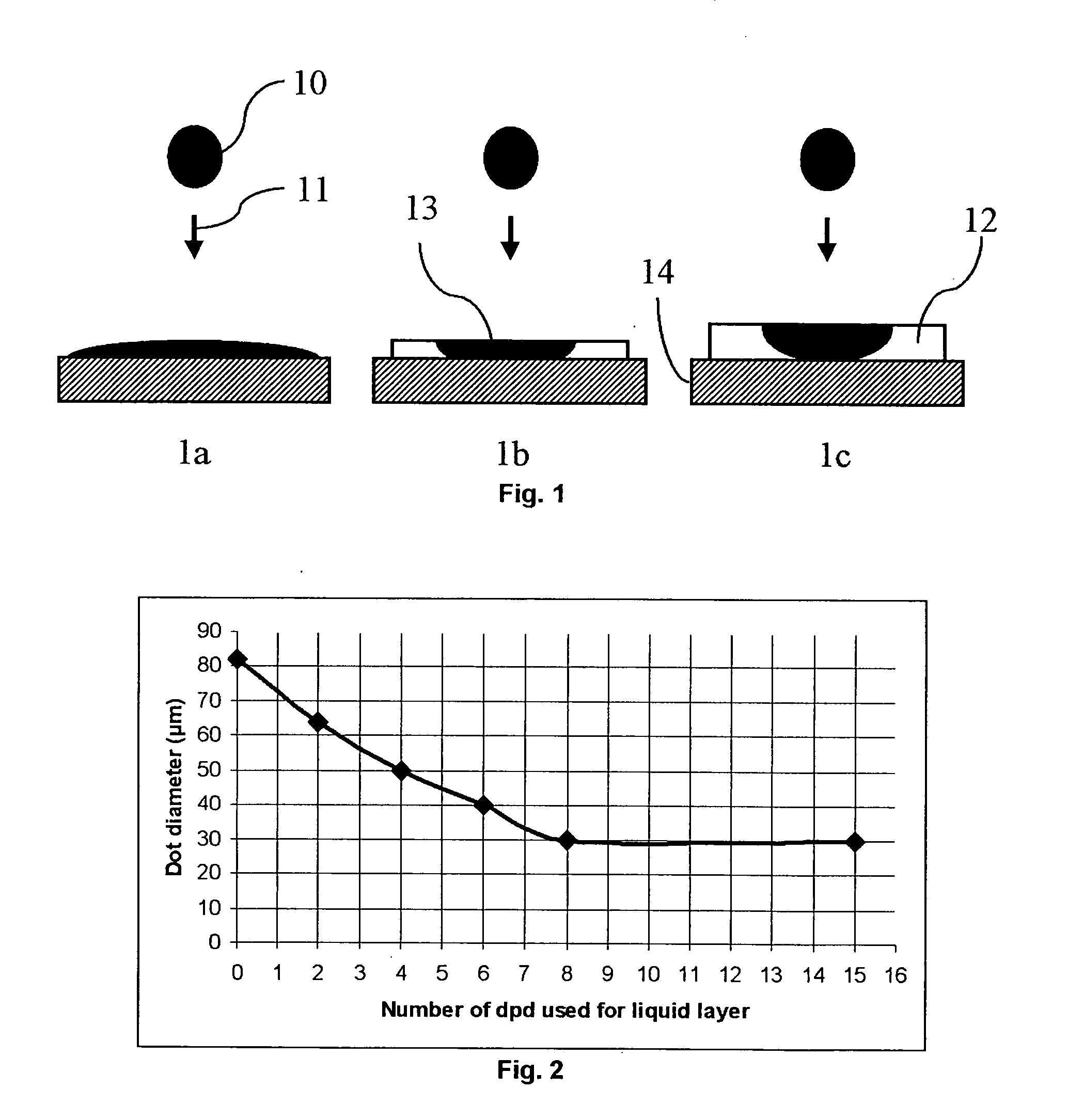Printing of radiation curable inks into a radiation curable liquid layer
a liquid layer and radiation curable technology, applied in pattern printing, printing, other printing apparatus, etc., can solve the problems of not being a viable solution in an industrial printing environment, changing inks in printers and print heads is very time-consuming, and the resolution of printed images is accurately controlled.
- Summary
- Abstract
- Description
- Claims
- Application Information
AI Technical Summary
Benefits of technology
Problems solved by technology
Method used
Image
Examples
example 1
[0208] This example illustrates how the dotsize of a ink droplet is controlled by the thickness.
Preparation of Radiation Curable Liquid Layer
[0209] A colourless radiation curable liquid layer composition Ink-L was prepared according to Table 1 by mixing the ingredients and stirring for one hour to ensure that all components were well distributed. The weight % (wt %) was based on the total weight of the radiation curable liquid layer composition.
TABLE 1wt % of:Ink-LDPGDA ™66.5Irgacure ™ 9072.5Darocur ™ ITX5.0Craynor ™ CN 50125.0Byk ™-3331.0
[0210] The radiation curable liquid layer composition INK-L was jetted on PET with a custom built ink-jet printer equipped with a UPH print head from AGFA to produce the ink receivers IR-2 to IR-7. A resolution of 360×360 dpi was used to print in a number of dpd (droplets per dot) as indicated by Table 2, wherein 1 dpd is equal to a droplet volume of 3 pL.
TABLE 2Ink receiver# dpd of Liquid layerIR-10IR-22IR-34IR-45IR-56IR-68IR-715
Preparatio...
example 2
[0216] In this example the dotsize of ink-jet inks jetted on the liquid layer after curing was evaluated.
[0217] An ink receiver IR-8 was prepared in the same manner as the ink receiver IR-7 of Example 1, except that the radiation curable ink-jet ink INK-M was used instead of INK-L. The ink receiver IR-5 of Example land the ink receiver IR-8 were first cured using a Fusion DRSE-120 conveyer, equipped with a Fusion VPS / 1600 lamp (D-bulb), which transported the ink receivers under the UV lamp on a conveyer belt at a speed of 20 m / min.
[0218] On the cured ink receivers IR-5 and IR-8, 1 dpd of the radiation curable ink-jet inks INK-M and INK-C were jetted at a resolution of 360×360 dpi with the custom built ink-jet printer. The printed samples were cured by the same procedure as used for curing the ink receivers IR-5 and IR-8. The radiation curable ink INK-M was not jetted on the ink receiver IR-8 since visual differentiation would be difficult. The dotsize was determined for each cured...
example 3
[0220] In this example the coalescence and gloss was evaluated.
Preparation of Radiation Curable Liquid Layer
[0221] A colourless radiation curable liquid layer composition Ink-L2 was prepared according to Table 6 by mixing the ingredients and stirring for five minutes. The weight % (wt %) was based on the total weight of the radiation curable liquid layer composition.
TABLE 6Wt % of:INK-L2Craynor ™ CN50170.0Irgacure ™ 50016.7Craynor ™ CN 3868.3Irgacure ™ 18703.3Byk ™-3331.7
Evaluation of the Properties
[0222] With the custom build printer equipped with a UPH head from AGFA the radiation curable liquid layer composition INK-L2 was jetted at 8 dpd and 360×360 dpi on half of the surface of a PET film. In a comparative sample COMP-1, the radiation curable inkjet ink INK-M was jetted onto the PET film, while in an inventive sample INV-1, the radiation curable inkjet ink INK-M was jetted into the liquid layer on the other half of the PET film. After UV-curing (Fusion VPS / 1600 lamp (D-b...
PUM
 Login to View More
Login to View More Abstract
Description
Claims
Application Information
 Login to View More
Login to View More - R&D
- Intellectual Property
- Life Sciences
- Materials
- Tech Scout
- Unparalleled Data Quality
- Higher Quality Content
- 60% Fewer Hallucinations
Browse by: Latest US Patents, China's latest patents, Technical Efficacy Thesaurus, Application Domain, Technology Topic, Popular Technical Reports.
© 2025 PatSnap. All rights reserved.Legal|Privacy policy|Modern Slavery Act Transparency Statement|Sitemap|About US| Contact US: help@patsnap.com


